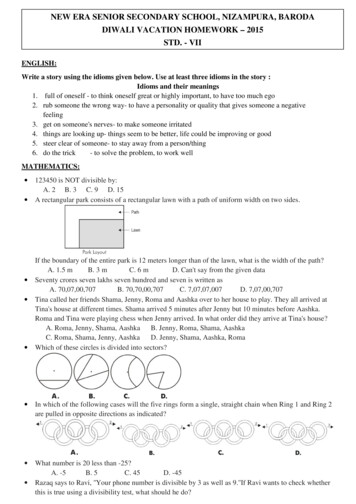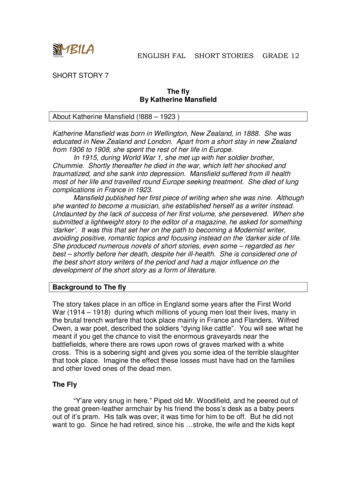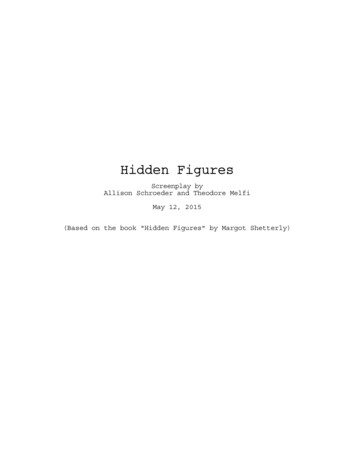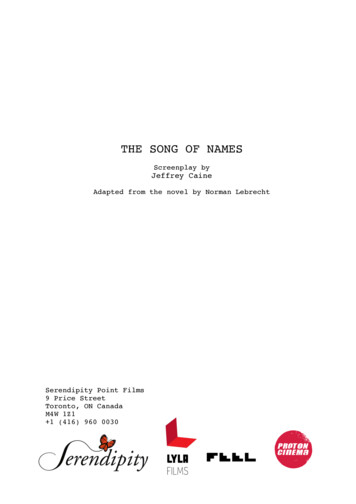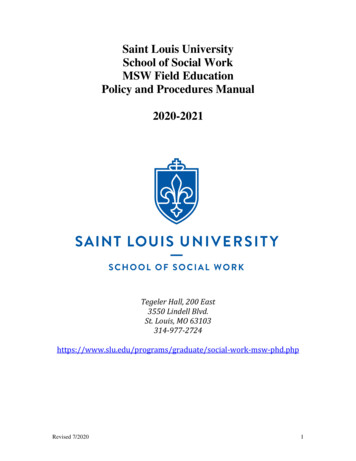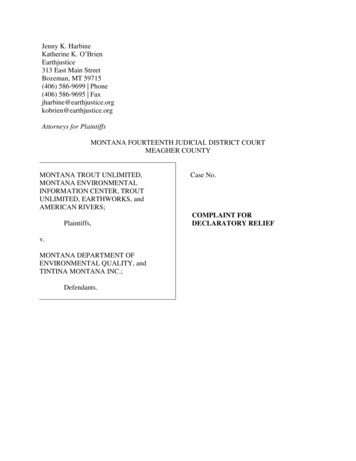
Transcription
Jenny K. HarbineKatherine K. O’BrienEarthjustice313 East Main StreetBozeman, MT 59715(406) 586-9699 Phone(406) 586-9695 rgAttorneys for PlaintiffsMONTANA FOURTEENTH JUDICIAL DISTRICT COURTMEAGHER COUNTYMONTANA TROUT UNLIMITED,MONTANA ENVIRONMENTALINFORMATION CENTER, TROUTUNLIMITED, EARTHWORKS, andAMERICAN RIVERS;Plaintiffs,v.MONTANA DEPARTMENT OFENVIRONMENTAL QUALITY, andTINTINA MONTANA INC.;Defendants.Case No.COMPLAINT FORDECLARATORY RELIEF
INTRODUCTION1.Plaintiffs Montana Trout Unlimited, Montana Environmental Information Center,Trout Unlimited, Earthworks, and American Rivers (collectively, “Plaintiffs”) challenge theMontana Department of Environmental Quality’s (“DEQ”) approval of Tintina Montana Inc.’s(“Tintina”) permit application for the Black Butte Copper Mine, a major copper mining projectproposed in the Smith River watershed of west-central Montana. The Smith River is one ofMontana’s premier recreational rivers due to its spectacular natural beauty and abundant wildtrout populations.2.Tintina’s proposed mine would excavate about 440 tons of concentrated copperore every day in the Smith River watershed. Over the life of the project, these mining activitieswould generate an estimated 12.9 million tons of tailings and nearly one million tons of wasterock and pollute waters within the Smith River watershed with metals and acid-generatingminerals that are harmful or lethal to aquatic life.3.DEQ is the agency charged with permitting mining activity under the Metal MineReclamation Act (“MMRA”), MCA § 82-4-301 et seq., and evaluating the environmentalimpacts of proposed mining activities under the Montana Environmental Policy Act (“MEPA”),MCA § 75-1-101 et seq. DEQ prepared and issued the permit, associated environmental impactstatement (“EIS”), and record of decision (“ROD”) approving Tintina’s proposed Black ButteCopper Mine in the Smith River watershed.4.However, in reaching its decision to issue the challenged permit, DEQ violatesnumerous requirements of the MMRA, MEPA, and their implementing regulations. Theseviolations include DEQ’s failure to follow the MMRA’s procedural and substantive requirementsfor ensuring that Tintina’s proposed tailings impoundment—the above-ground facility that would1
hold millions of tons of toxic and acid-generating tailings and rock waste—remains safe andstable in the near and long term. DEQ also fails to rationally evaluate, as MEPA requires,significant environmental consequences of the mine. Such consequences include the potentialthat Tintina’s proposed tailings facility will fail to contain toxic mine waste—an event madelikelier by DEQ’s failure to ensure the facility meets MMRA safety standards. In addition, DEQdoes not rationally evaluate the proposed mine’s potential to pollute and deplete streamflows inmajor Smith River tributaries, in turn harming the fish populations that depend on clean, coldwater. DEQ also does not meaningfully and rationally evaluate feasible alternatives to theproposed action, including alternatives that could reduce some of the project’s most significantenvironmental impacts.5.To safeguard their interests in the waters and native and wild fish threatened byDEQ’s unlawful permit approval, Plaintiffs seek relief from this Court.JURISDICTION AND VENUE6.Plaintiffs bring this action pursuant to the Uniform Declaratory Judgments Act,MCA §§ 27-8-201, 202; the Montana Environmental Policy Act, MCA § 75-1-101 et seq.; andthe Metal Mine Reclamation Act, MCA § 82-4-301 et seq.7.Venue is proper in this District because the mining project Plaintiffs challengewould occur in Meagher County. MCA §§ 25-2-126(1), 75-1-108, 82-4-349(2).PARTIES8.Plaintiff Montana Trout Unlimited is a statewide grassroots non-profitorganization located in Missoula, Montana, and is dedicated to conserving and restoring coldwater fisheries throughout the state. Montana Trout Unlimited members live and recreate in theSmith River watershed where Tintina’s copper mine is proposed. Montana Trout Unlimited has2
helped fund fishery research and restorations in the Smith River, participated as a stakeholder inSmith River management decisions by state agencies, and served as lead plaintiff in a case thatestablished the Smith River watershed as a closed basin under the Montana Water Use Act.9.Plaintiff Montana Environmental Information Center (“MEIC”) is a member-supported Montana non-profit organization based in Helena, Montana. Founded in 1973, MEICrepresents approximately 5,000 members from across Montana and the United States. MEIC isdedicated to, among other things, protecting Montana’s water quality and ensuring compliancewith the laws and Constitution of Montana. MEIC has litigated numerous water protection casesrelated to metal mining in Montana. MEIC members live near, recreate in, and otherwise derivebenefit from the public lands and waters in the Smith River watershed.10.Plaintiff Trout Unlimited is a Michigan non-profit corporation headquartered inArlington, Virginia with 387 affiliated chapters across the United States, including 12 chapters inMontana. Trout Unlimited’s mission is to conserve, protect, and restore North America’s coldwater fisheries and their watersheds. Trout Unlimited grassroots chapter volunteers and nationalstaff have engaged in extensive public education and advocacy to protect the Smith Riverwatershed and associated aquatic life from the adverse effects of Tintina’s proposed Black ButteMine.11.Plaintiff Earthworks is a non-profit organization dedicated to protectingcommunities and the environment from the adverse impacts of mineral and energy developmentwhile promoting sustainable solutions. Earthworks is headquartered in Washington, D.C., andhas offices around the country, including in Missoula, Montana. Earthworks has employed itsextensive research and advocacy experience to protect the Smith River watershed and educatethe public about the environmental impacts of hardrock mining in Montana.3
12.Plaintiff American Rivers, Inc. is a non-profit conservation organizationcommitted to protecting clean water in rivers across the nation to ensure ample supplies for fish,wildlife, agriculture, and communities. Headquartered in Washington, D.C., American Rivershas field offices across the country, including in Bozeman, Montana. American Rivers and itsmembers value and derive benefit from the Smith River and its tributaries for their wild, freeflowing character, clean water, abundant fish and wildlife, and world class recreationalopportunities.13.All plaintiffs have longstanding interests in protecting water quality within theSmith River watershed because they and their members place a high value on the continuedhealthy functioning of the ecosystems that support thriving trout populations and depend on theclean, cold water of the Smith River and its tributaries. Plaintiffs have been actively seeking toprotect the Smith River watershed through a wide array of actions, including public outreach andeducation, scientific analysis, and advocacy intended to promote healthy ecosystem functioningin the region. Plaintiffs submitted comments during the MEPA process detailing significantconcerns with DEQ’s analyses of the environmental impacts threated by the proposed mine.14.Members of the plaintiff organizations also depend on the Smith River and itstributaries for traditional activities, recreational pursuits, and employment, including outfitting,guiding, angling, floating, swimming, wildlife viewing, and aesthetic enjoyment. In doing so,Plaintiffs rely upon the water quality of the Smith River watershed to sustain the ecosystems thatenable these pursuits. Plaintiffs derive economic, aesthetic, recreational, scientific, inspirational,and other benefits from these activities.15.Tintina’s proposed Black Butte Copper Mine threatens to damage water qualityand reduce surface water quantities within the Smith River watershed, thereby harming4
Plaintiffs’ members’ opportunities to fish the Smith River’s world-class trout fishery, enjoy thepopular and spectacular 59-mile float of the river, study the wildlife supported by the SmithRiver watershed, and carry out businesses dependent upon the health of the watershed andassociated recreation and tourism. The legal violations alleged in this complaint therefore causedirect injury to the economic, aesthetic, conservation, recreational, scientific, educational,spiritual, and wildlife preservation interests of Plaintiffs and their members.16.Defendant Montana Department of Environmental Quality is the agency chargedwith issuing exploration and mining permits under the Metal Mine Reclamation Act, MCA § 824-332, and evaluating the environmental impacts of proposed exploration and mining activitiesunder MEPA, MCA § 75-1-201.17.Defendant Tintina Montana Inc. applied for—and upon payment of the requisitebond, will hold—the mine operating permit that is challenged in this proceeding. Plaintiffs donot seek any relief against Tintina Montana, Inc., but name the company as a necessary party tothis action under MCA § 27-8-301. On information and belief, Tintina Montana Inc. also doesbusiness as Tintina Resources Inc. and is a subsidiary of the Canadian corporation SandfireResources America Inc.LEGAL BACKGROUND18.DEQ’s consideration of the Black Butte Copper Mine is subject to statutoryrequirements under the MMRA and MEPA that are intended to ensure that such projects do notcause unreasonable environmental harm and that implement the environmental mandates of theMontana Constitution, Mont. Const. art. II, § 3 and art. IX, § 1.5
MONTANA’S METAL MINING RECLAMATION ACTI.19.The MMRA was enacted to allow for mining activity in Montana while“provid[ing] adequate remedies for the protection of the environmental life support system fromdegradation and provid[ing] adequate remedies to prevent unreasonable depletion anddegradation of natural resources.” MCA § 82-4-301(2)(a). Among other requirements, theMMRA mandates that tailings storage facilities meet rigorous design standards, use appropriatetechnologies and techniques, and provide for “protection of human health and the environment.”Id. § 82-4-301(2)(b). The Legislature also mandated “proper reclamation of mined land toprevent undesirable land and surface water conditions detrimental to the general welfare, health,safety, ecology, and property rights of the citizens of the state.” Id. § 82-4-301(3).20.Before engaging in mining activities, the MMRA requires a person to obtain amine operating permit from DEQ. Id. § 82-4-335(1). Among other things, an application for amine operating permit must include a plan detailing the design, operation, and monitoring ofstructures that will impound mine waste and water, and such plan must be “sufficient to ensurethat the structures are safe and stable.” Id. § 82-4-335(5)(l) (emphasis added). For largeimpounding structures that meet the MMRA’s definition of “tailings storage facilit[ies],” id. §82-4-303(34), permit applicants must meet additional, more stringent procedural and substantiverequirements under MCA §§ 82-4-376 and 82-4-377.1 These requirements include thesubmission of a design document, certified by an engineer, which evaluates the potential forproposed tailings facilities to release pollutants into the environment. Id. § 82-4-376(2). “TheThe MMRA defines “tailings storage facility” as a “facility that temporarily or permanentlystores tailings ” excluding facilities that “store[] 50 acre-feet or less of free water or processsolution.” MCA § 82-4-303(34).16
design document must be submitted prior to the issuance of the draft permit” by DEQ, id. § 82-4376(3), and reviewed and approved by an “independent review panel,” id. § 82-4-377.21.Additionally, mine permit applicants must submit a reclamation plan for DEQapproval “provid[ing] sufficient measures to ensure public safety and to prevent the pollution ofair or water and the degradation of adjacent lands.” Id. § 82-4-336(10). The plan must providefor post-mining restoration of disturbed areas and “include, if applicable, the requirements forpostclosure monitoring of a tailings storage facility agreed to by a panel pursuant to 82-4-377.”Id. § 82-4-336(1), (13).22.DEQ may not issue an operating permit to an applicant that fails to meet thesestandards. See id. § 82-4-351 (providing reasons for permit denial).II.MONTANA ENVIRONMENTAL POLICY ACT23.DEQ’s authorization of the proposed mine is also subject to the environmentalreview requirements of MEPA, MCA § 75-1-101 et seq. MEPA is designed “to promote effortsthat will prevent, mitigate, or eliminate damage to the environment” and promote human healthand welfare. Id. § 75-1-102(2). To meet this purpose, MEPA requires DEQ to “take a ‘hardlook’ at the environmental impacts of a given project or proposal.” Mont. Wildlife Fed’n v.Mont. Bd. of Oil & Gas Conservation, 2012 MT 128, ¶ 43, 365 Mont. 232, 280 P.3d 877. DEQmust prepare an environmental impact statement (“EIS”) before authorizing a proposed project ifthe project would “significantly affect[] the quality of the human environment.” ARM17.4.607(1); see also MCA § 75-1-201(1)(b)(iv) (requirements for preparation of environmentalimpact statement); ARM. 17.4.609(3)(d) (same).24.In an EIS, the agency must disclose and consider, among other things, the direct,indirect, and cumulative environmental impacts of the action. MCA § 75-1-201(1)(b)(iv), ARM7
17.4.609(3)(d) (requiring an evaluation of “impacts, including cumulative and secondaryimpacts, on the physical environment” and “the economic advantages and disadvantages of theproposal”). As part of this consideration, DEQ’s rules require it to determine the significance ofan action’s individual and cumulative impacts, based on its evaluation of the probability andseverity of impacts, growth-inducing aspects of the proposal, and “the importance to the stateand to society of each environmental resource or value that would be affected.” ARM17.4.608(1). Further, DEQ may not dismiss potentially severe impacts as insignificant without“reasonable assurance that the impact will not occur.” ARM 17.4.608(1)(b).25.Additionally, DEQ must evaluate reasonable alternatives to the proposed action.MCA § 75-1-201(1)(b)(iv)(C), (v). An “[a]lternative” is “an alternate approach or course ofaction that would appreciably accomplish the same objectives or results as the proposed action,”and includes alternate “design parameters, mitigation, or controls other than those incorporatedinto a proposed action by an applicant or by an agency prior to preparation of an EA or draftEIS.” ARM 17.4.603(2)(a). Alternatives must be “achievable under current technology” and“economically feasible as determined solely by the economic viability for similar projects havingsimilar conditions and physical locations and determined without regard to the economic strengthof the specific project sponsor.” MCA § 75-1-201(1)(b)(iv)(C).26.DEQ must make a draft EIS available to the public and responsible state andfederal agencies for public comment, ARM 17.4.620, and must respond to substantive commentsin a final EIS, id. 17.4.619.27.Following its issuance of a final EIS, DEQ must issue a “record of decision” thatprovides “public notice of what the decision is, the reasons for the decision, and any specialconditions surrounding the decision or its implementation.” ARM 17.4.629.8
In evaluating environmental impacts pursuant to MEPA, “[t]he agency must28.examine the relevant data and articulate a satisfactory explanation for its action, including arational connection between the facts found and the choice made.” Mont. Wildlife Fed’n, ¶ 43(quoting Clark Fork Coal. v. Mont. Dep’t of Env. Quality, 2008 MT 407, ¶ 47, 347 Mont. 197,197 P.3d 482).THE MONTANA CONSTITUTION’S ENVIRONMENTAL PROTECTIONSIII.29.Montana’s Constitution compels the state to prevent unreasonable environmentaldegradation to protect the public’s right to a clean and healthful environment. The MontanaConstitution protects Montanans’ inalienable “right to a clean and healthful environment,” andrequires that “[t]he state and each person shall maintain and improve a clean and healthfulenvironment in Montana for present and future generations.” Mont. Const. art. II, § 3; art. IX, §1(1). In addition, the Constitution requires that the Montana Legislature “shall provideadequate remedies to prevent unreasonable depletion and degradation of natural resources.” Id.,art. IX, § 1(3).30.In enacting these provisions, the drafters of Montana’s Constitution aimed toestablish “the strongest environmental protection provision found in any state constitution.”Mont. Envtl. Info. Ctr. v. Dep’t of Envtl. Quality (“MEIC”), 1999 MT 248, ¶ 66, 296 Mont. 207,988 P.2d 1236 (citing Mont. Const. Convention, vol. IV at 1200 (Mar. 1, 1972)). To that end,these provisions do not “merely prohibit that degree of environmental degradation which can beconclusively linked to ill health or physical endangerment.” MEIC, ¶ 77. Rather, they provideenvironmental “protections which are both anticipatory and preventative.” Id.31.The Montana Legislature enacted the MMRA and MEPA to meet itsconstitutional obligation to prevent unreasonable environmental degradation. See 2003 Mont.9
Laws ch. 361, § 5 (HB 437); see also MCA §§ 75-1-102(1) (MEPA’s purpose), 82-4-302(MMRA’s purpose). Accordingly, those statutes must be interpreted to serve their constitutionalpurpose. To the extent any provision of the MMRA or MEPA allows for unreasonableenvironmental degradation, it would violate Plaintiffs’ environmental rights guaranteed byArticle II, Section 3 and Article IX, Section 1 of the Montana Constitution. See MEIC, ¶ 80.FACTUAL BACKGROUNDI.THE SMITH RIVER32.Montana’s Smith River is renowned for its spectacular scenery, toweringlimestone canyons, and prized trout fishery. The Smith River originates high in the CastleMountains of central Montana and flows through remote canyons before emptying into theMissouri River about 10 miles upstream of Great Falls. The Smith River has long proved anexceptional fishing and recreational resource to Montanans, and state agencies as well as theMontana Legislature have recognized the Smith River’s importance by granting it specialprotections under the law.33.In 1969, in response to increasing threats to the Smith River’s exceptional waterquality and abundant trout populations, the Montana Fish and Game Commission designatednearly 60 miles of the River as a State Recreational Waterway. In 1989, the Montana Legislatureenacted the Smith River Management Act, MCA § 23-2-401 et seq., which specifically requiresthe State to manage the Smith River to: “(1) allow the continuation of compatible existingrecreational public land uses; (2) maintain the opportunity to enjoy the natural scenic beauty andsolitude; and (3) conserve fish and wildlife and scientific and recreational values.” Id. § 23-2407.10
34.As a result of these protections, as well as the high public demand to experiencethe Smith River’s exceptional fishing and recreational opportunities, the Smith River isMontana’s only river subject to a recreational permitting program. In recent years, MontanaFish, Wildlife and Parks (“FWP”) has awarded roughly 1,000 permits annually from the morethan 10,000 applications received every year to float the Smith. A 2013 survey found that theSmith River hosted more than 23,000 angler days. Tributaries of the Smith are important troutfisheries in their own right: for example, Sheep Creek, which is adjacent to the proposed BlackButte Mine site, supported 1,139 angler days in 2013.35.For these reasons, the Smith River watershed is an important economic engine,and recreation in the watershed generates more than 11 million annually. Recreation on theSmith supports a robust outfitting and guiding industry, generating over 3.2 million in salaries,wages, and proprietary income, and producing more than 800,000 in state and local tax revenueannually. Such recreational activities also provide a dependable revenue stream for FWP, whichcollected over 360,000 in fees from Smith River floaters in 2018 and more than 380,000 infees in 2019.36.In addition to providing significant economic benefits from recreational activities,the Smith River watershed also serves as an essential water resource for local ranchers andfarmers. According to the U.S. Geological Survey, “most of the water used to irrigate 36,000acres [of agricultural lands] of the upper Smith River watershed is withdrawn from the SmithRiver or its tributaries.”2 Such withdrawals accounted for about 845,000 cubic meters of waterper day, irrigating lands used to grow hay (grass and alfalfa), wheat, barley, and other crops.2Smith River Watershed Investigations, USGS, ith-river-watershed-investigations?qt-science center objects 0#qtscience center objects (last visited June 3, 2020).11
37.The Smith River and its tributaries also provide crucial habitat and spawninggrounds for regional trout fisheries. The Sheep Creek watershed accounts for more than half oftributary spawning of rainbow trout in the Smith River drainage, and rainbow trout are known totravel nearly 200 miles round-trip from the Missouri River to spawn in the Sheep Creekwatershed. Westslope cutthroat trout, a sensitive species designated as vulnerable to extirpationin Montana are also reported to occur in Sheep Creek near Tintina’s proposed mine.38.The Smith River ecosystem depends on clean, cold water from the river’stributaries to sustain the aquatic life within its banks and the agricultural operations along it.Indeed, Sheep Creek provides nearly half of the flow of the Smith River at their confluenceduring late summer baseflows. Demands on the river’s waters already exceed available flows inmany years, creating challenges for fish populations and water users.II.THE BLACK BUTTE MINE39.The Black Butte Mine would be located in the Sheep Creek basin within theSmith River watershed, about 19 river miles upstream from the mainstem Smith River.40.Tintina proposes to extract 14.5 million tons of copper ore from the Johnny LeeDeposit—about 440 tons of copper per day over the 13-year active lifetime of the mine. Onaverage, eighteen trucks carrying the concentrate would leave the mine every day for nearby railterminals in Livingston and/or Townsend. The mine would also generate approximately 12.9million tons of tailings—acid-generating processed minerals separated from the copper ore—and0.8 million tons of waste rock.41.The Johnny Lee Deposit is a sulfide ore body, which contains minerals thatproduce high levels of acids and toxic metals when exposed to air and water. Mining sulfide orebodies, particularly in close proximity to ground or surface water, presents inherent pollution12
risks and requires careful water treatment and tailings waste management to avoid dischargingnoxious chemicals to adjacent groundwater or surface water. Even with such steps, mines insulfide ore bodies frequently contaminate groundwater and nearby surface water. Sulfide-oremines in Montana and across the country have caused severe pollution of drinking wateraquifers, farmland, and surface waters, and resulted in losses of fish and wildlife and theirhabitat. At numerous mine sites, water quality impacts are so severe that acid mine drainage willgenerate water pollution in perpetuity. In addition to environmental consequences, Montana hassuffered serious economic consequences from such pollution, for which reclamation bondsintended to fund clean-up efforts often prove inadequate. For example, the Zortman-Landuskyand Beal Mountain mines, which both were developed in sulfide ore bodies, have saddledMontana taxpayers with ongoing liability for unfunded clean-up costs of 78.9– 103.8 million.For the Zortman-Landusky mine, alone, DEQ has estimated annual water treatment costs of 22.5 million, in perpetuity.42.Excavating the Black Butte Mine would cause a substantial drawdown in the localwater table, as groundwater is continuously pumped to the surface to prevent it from filling themine void. Tintina estimates that it would withdraw approximately 800 acre-feet of groundwaterannually. During mine operations, drawdown adjacent to the mine would lower the water tableby 100 to 200 feet; drawdown on the order of ten feet would occur as far as 1.5 miles away fromthe mine site. FEIS at 3.4-40. The EIS acknowledges that the mine would cause drawdown anda loss of surface water flow in Sheep Creek, Coon Creek, and Black Butte Creek—including aloss of 70 percent of base flow in Coon Creek. And groundwater drawdown would deplete flowsto nearby springs and seeps, potentially causing some to dry up.13
43.DEQ’s approval of the mine relies in part on Tintina’s ability to mitigate theselosses of surface water flows. Tintina has conceived a complex plan to attempt to mitigate theimpacts of groundwater drawdown on the Smith River’s important tributaries. The plan includesacquiring water rights from existing agricultural water users to retain such water instream,treating and discharging water pumped from the mine workings into the Sheep Creek alluvialaquifer through an underground injection gallery, seepage from a water storage pond, andpumping water from Sheep Creek under high flow conditions, and discharging it into SheepCreek and Coon Creek in summer months when flows are diminished. Id. at 2-8, 2-11. Tintinahas applied for, but has not yet obtained, approval from the Montana Department of NaturalResources and Conservation (“DNRC”) for this mitigation scheme.44.As part of mine operations, Tintina would continuously pump groundwater drawninto mine shafts and voids. Because this groundwater would carry high levels of metals andnutrients inside the mine, Tintina proposes to treat groundwater that it does not consumptivelyuse in mine operations in a reverse osmosis plant before discharging it to an undergroundinfiltration gallery, which would consist of a network of tunnels in the alluvial aquifer underSheep Creek. Tintina would discharge water to the underground infiltration gallery at an averagerate of 398 gallons per minute. Id. at 2-12. After passing through the alluvial aquifer, theeffluent would eventually discharge to Sheep Creek. Id. at 3.4-53.45.The reverse osmosis treatment may not sufficiently reduce nitrogen levels in thepumped groundwater to meet stricter summer standards intended to reduce nuisance algae inSheep Creek and the Smith River. See id. at 2-8, 8-164. To circumvent this problem, Tintinaplans to store treated wastewater in a pond during the summer months and recommence14
discharge in October each year when the stricter nitrogen standards are no longer in force. Id. at8-58, 8-261.46.The 12.9 million tons of tailings and 0.8 million tons of rock waste generated byTintina’s excavation activities would contain high levels of acid-generating minerals and toxicmetals, including nickel, thallium, strontium, copper, lead, arsenic, and uranium. See id. at 3.611. Tintina would dispose of about half of the tailings by backfilling underground areas of themine with a mixture of cement and tailings. Tintina would deposit the remainder of the tailingsand all of the waste rock aboveground in a tailings facility. Id. at 2-11.47.The 72-acre tailings facility—which would cover more area than 54 footballfields—would sit on the side of a hill overlooking Sheep Creek. Id. at 2-3, 2-5. According toTintina’s specifications, an earthen dam would prevent the tailings facility from collapsing anddischarging mine waste directly into Sheep Creek. Tintina proposes a novel and untestedmethodology for stabilizing and containing these wastes that involves mixing the tailings withcement to provide structural stability. Should that method fail, Sheep Creek and its fisherywould be devastated, and long-term or permanent harm to the mainstem Smith River likelywould occur as well.III.DEQ’S REVIEW AND APPROVAL OF THE BLACK BUTTE MINE48.Tintina submitted an application to DEQ for a mine operating permit under theMMRA on December 15, 2015. DEQ, as well as Plaintiffs and independent technical experts,identified deficiencies in Tintina’s application. As a result, on September 16, 2016, Tintinasubmitted “new and voluminous material that was lacking in the initial application, in particularsections on hydrology and geochemistry.” DEQ, Second Deficiency Review, Pending OperatingPermit 00188 at 1 (Dec. 15, 2016). Nevertheless, DEQ identified ongoing “major concerns”15
with Tintina’s application related to geochemical testing and modeling, hydrological modeling,and Tintina’s estimates for the duration of water treatment following mine closure. Id. Tintinasubmitted revisions to its application on May 8 and July 14, 2017. DEQ issued a draft mineoperating permit for Tintina in September 2017, and commenced its review of Tintina’s draftpermit under MEPA.49.DEQ issued a Draft EIS for public comment in March 2019. In response, DEQreceived more than 12,000 comments from the public—including numerous reports fromindependent technical experts—the vast majority of which were critical of the mine proposal.Despite these criticisms, DEQ issued a Final EIS on March 13, 2020 without addressingsubstantial issues raised in public comments. On April 9, 2020, DEQ issued a Record ofDecision approving the issuance of final operating permit for the Black Butte Copper Mine basedon the Final EIS’s analysis.A.DEQ’s Analysis of the Safety and Stability of the Tailings Facility50.With DEQ’s authorization, Tintina proposes to bind tailings with cement andstore them in an above-ground facility—an untested method for disposing of mine tailings. Overmine’s active life, Tintina would pour millions of tons of toxic cement paste tailings, layer bylayer, into the facility. According to DEQ, the structural integrity of T
Jenny K. Harbine Katherine K. O'Brien Earthjustice 313 East Main Street Bozeman, MT 59715 (406) 586-9699 Phone (406) 586-9695 Fax jharbine@earthjustice.org kobrien@earthjustice.org Attorneys for Plaintiffs MONTANA FOURTEENTH JUDICIAL DISTRICT COURT MEAGHER COUNTY MONTANA TROUT UNLIMITED, MONTANA ENVIRONMENTAL INFORMATION CENTER, TROUT
